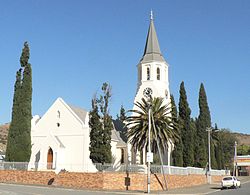Victoria West, Northern Cape
|
Victoria West Victoria-Wes |
||
|---|---|---|

Dutch Reformed Church, Victoria West
|
||
|
||
| Coordinates: 31°24′11″S 23°07′14″E / 31.40306°S 23.12056°ECoordinates: 31°24′11″S 23°07′14″E / 31.40306°S 23.12056°E | ||
| Country | South Africa | |
| Province | Northern Cape | |
| District | Pixley ka Seme | |
| Municipality | Ubuntu | |
| Established | 1844 | |
| Area | ||
| • Total | 78.95 km2 (30.48 sq mi) | |
| Population (2011) | ||
| • Total | 8,254 | |
| • Density | 100/km2 (270/sq mi) | |
| Racial makeup (2011) | ||
| • Black African | 23.7% | |
| • Coloured | 69.3% | |
| • Indian/Asian | 0.4% | |
| • White | 5.6% | |
| • Other | 0.9% | |
| First languages (2011) | ||
| • Afrikaans | 82.1% | |
| • Xhosa | 13.8% | |
| • English | 1.1% | |
| • Other | 3.0% | |
| Time zone | SAST (UTC+2) | |
| Postal code (street) | 7070 | |
| PO box | 7070 | |
| Area code | 053 | |
Victoria West is a town in the central Karoo region of South Africa's Northern Cape province. It is situated on the main N12 route, at an elevation of 1,300 metres (4,300 ft). It is the seat of the Ubuntu Local Municipality within the Pixley ka Seme District Municipality.
The town was laid out on the bank of the Brakrivier watercourse in 1843, when the Dutch Reformed Church bought the farm Zeekoegat from the estate of J.H. Classens. It was named Victoria in 1844, after Queen Victoria, though amended to Victoria West in 1855 to distinguish it from an Eastern Cape district.. In 1859 the town acquired municipal status.
The first services of the Dutch Reformed Church were led by Rev. Colin Fraser of Beaufort West in the “Kerkhuis” on the farm Kapoksfontein. The congregation in Victoria West separated from that in Beaufort West during October 1843 when the first local preacher, Rev. W.E. Krige was ordained. For various practical reasons, they decided not to establish the town on the farm Kapoksfontein but rather Zeekoegat. Church services were temporarily held in a house on Zeekoegat. There was a need for a comfortable church building and fund raising was started.
The history of the Dutch Reformed Church is set out in a display at the Victoria West Regional Museum, consisting of documents, photographs, maps, Bibles, items of the first Communion Service and the church's first organ. The church was declared a National Monument in 1992.
With the pastoral industry growing, the setting up of a wool market was proposed. The Victoria West Wool Auctions began in 1884 and were well enough supported to justify their being held twice a month. As the market slumped, the activities came to an end. In 1892 an unsuccessful effort was made to revive them.
In April 1921, the Municipal Dam, which was approved at a public meeting in 1913 but delayed through cement shortages, was at last completed. A picnic for the benefit for all the children was followed in the evening by a dance. Boats were introduced for the convenience of the public, and a great debate arose as to the bathing facilities. “Proper shelter and protection must be sought and provided by the bathers while dressing and undressing. Bathers must be dressed in a costume sufficient to cover the body decently from shoulder to halfway between the hip and knee”. The Municipal Dam is still in use, but the rules regarding swimwear are more relaxed.
...
Wikipedia




